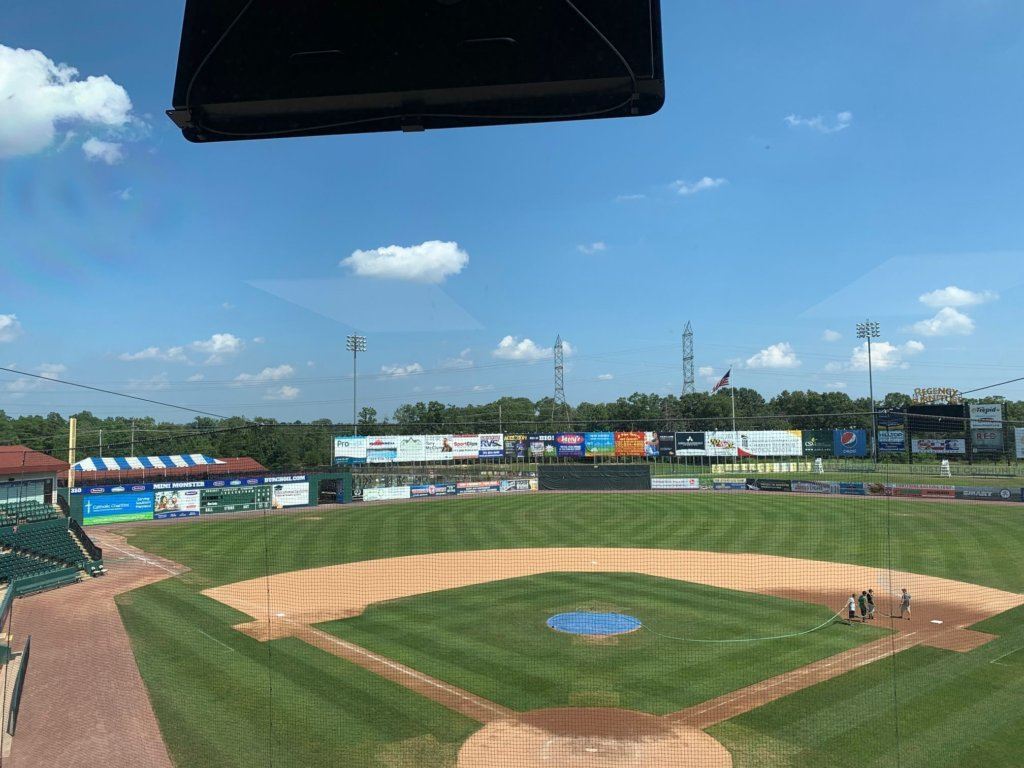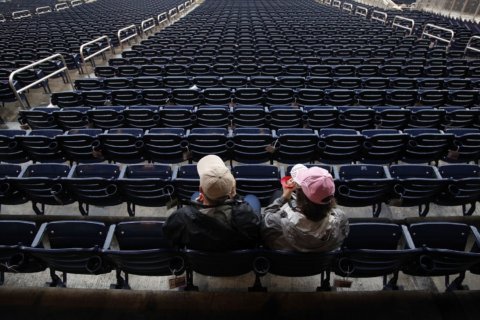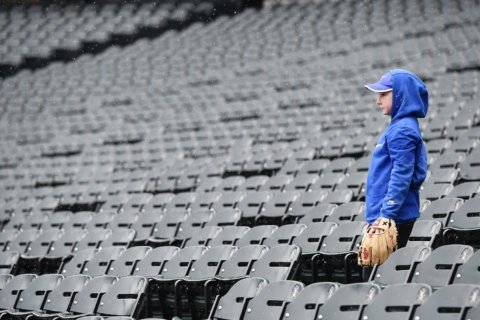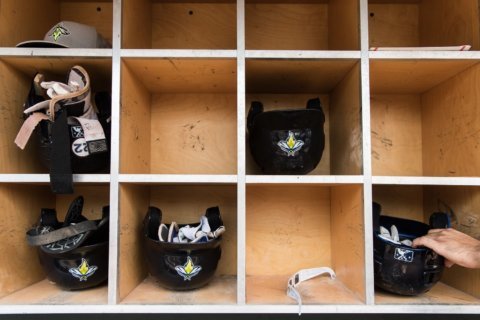Baseball is a game of adjustments. It’s a game of routines and traditions as well, though, many of which are held to more fiercely than in any other sport. So what happens when some of the most fundamental of those traditions — the very way the game is played — are suddenly changed?
Robot umpires? Batters stealing first base? This season, Major League Baseball is partnering with the Atlantic League, an independent professional baseball league not directly affiliated with any big league organizations, to use it as a sandbox for potential rule changes. Some came into play at the beginning of the year, while an additional spate of them came in suddenly after the All-Star break. The eight-team league includes the Southern Maryland Blue Crabs, who play in Waldorf.
Earlier today, @MLB and the @AtlanticLg announced the experimental playing rules and equipment that will be in place during the 2019 Atlantic League
Championship Season. pic.twitter.com/3pZlHeJH8e— MLB Communications (@MLB_PR) March 8, 2019
Chris Young, a 13-year MLB veteran who pitched in the Nationals minor league system in 2013, is now MLB’s VP of on-field operations, initiatives & strategy. He addressed a contingent from the Atlantic League about the new rules this spring at Detroit Tigers camp in Lakeland, Florida.
“At first when you heard about it, it was a shock to everybody,” said Blue Crabs manager Stan Cliburn. “There was a lot of controversy, a lot of talk … But any time you have change, you’re going to have that.”
If there’s any animosity from the players and coaches upon whom the new rules have been foisted, they’re not showing it. Perhaps that’s because one of their own, Tony Thomas, was the first to take full advantage.
One of the new rules allows for a batter to try to advance to first on any pitch that the catcher does not cleanly receive, no matter the count. Once the player leaves the batter’s box with both feet, he’s committed to trying to get to first before the throw. But such a scenario goes against a lifetime of training, especially for a veteran like Thomas, a 33-year-old in his 13th professional season. All that history explains the moment of hesitation before he made history, becoming the first professional baseball player to steal first base.
For the first time in baseball history a player stole first base thanks to the Atlantic League-MLB partnership rule changes! @ESPNAssignDesk pic.twitter.com/yj4FkcZg6O
— SoMD Blue Crabs (@BlueCrabs) July 14, 2019
Whether any of the rules are ultimately adopted by MLB and lead to some sort of reinvigorated interest in and financial boon for the game remains to be seen. But for now, at least someone will be $300 richer. Blue Crabs ownership offered a $100 bounty for the player with the most steals of first this season, with Cliburn and bench coach Joe Walsh each matching the contribution. The only catch — it’ll cost a player $5 every time he’s caught.
After a slow adoption by the players — Thomas was still the only player to attempt to swipe first for the Blue Crabs through Saturday’s game, more than a week after the All-Star Break — the league upped the ante as well. Originally, the play was scored as a fielder’s choice, meaning it would hurt the batter’s average and on-base percentage. That scoring has been changed to a walk, further incentivizing hitters to make a break for it.
So, will that work?
“Absolutely,” said Cliburn. “You’re going to see guys take off left and right, now. I really believe that.”
He’s got good reason to think the old scoring was affecting the thought process. After all, everyone in the Atlantic League is striving to get out, to get noticed by a big league club (there was at least one scout present Friday night), and they’ll take every bit of help to their numbers they can get.
“I’ve seen hitters that balls have gotten by, I’ve heard them have a conversation with the catcher, and asked my catcher after the inning’s over what the conversation’s about,” said Cliburn, re-enacting the conversation from the hitter’s perspective. “‘I’m not running to first base. I’m going to get a hit right here and go 1-for-1 instead of running down to first base and going 0-for-1.’”
And while that may help force the adoption of the new rule, not everyone thinks that’s a reasonable way to go about the scoring.
“I don’t think it’s fair for the pitchers to give a guy a walk where it’s a credit to his on-base percentage and a negative to the pitcher’s WHIP,” said Blue Crabs relief pitcher Kevin Munson. “You could be in an 0-2 count and be credited with a walk when a guy just takes a pitch.”
He suggests a new statistical category that wouldn’t punish pitchers who, of course, are trying to put up their own best possible stat lines.
Interestingly, Munson is less concerned with the other rule changes, both real and suggested, intended to make life tougher on pitchers and promote offense. As a right-handed pitcher, the new rule that pitchers have to step completely off the rubber before throwing a pickoff don’t affect him much. He dealt with the pitch clock instituted in the minors back when he was in Triple-A a few years ago, so he’s used to adjusting on the fly. Even if the proposed mound shift eventually happens (it’s been pushed back for now), he sees it as a potential positive.
“I think it’s good to be on the front lines. If they move the mound back to 62’6” and you do well, you’ll be a guy they’re definitely going to consider as somebody who’s already done it,” he said.
He’s also looking forward to the full implementation of the Trackman system — which will signal balls and strikes to umpires — which is still coming online stadium-by-stadium around the league. The Blue Crabs are looking at August 2 to hopefully be up and running at Regency Furniture Stadium.
“The electronic strike zone, to me, makes it easier for the pitcher and the umpire,” said Munson, pausing for a second. “And the catcher. And the hitter. Across the board, it makes it better for everybody. We have a consistency that they can live with and we can live with. And it kind of settles the great debate of who’s right.”
Early on in Friday night’s contest between Southern Maryland and the visiting Sugar Land Skeeters, Blue Crabs catcher Charlie Valerio takes a borderline strike on the outside, turning and voicing his displeasure to home plate umpire Scott Hart. While the pitches are being tracked upstairs in the press box, and while Hart has been prepped on the particulars of the system, he’s not wearing the earbuds Friday night, not yet.
“It’s fairly instantaneous,” said Hart, a second-year Atlantic League ump, of the notifications, which he first heard during training earlier last week. “I know there are still things they’re working on as far as internet connections and things like that … But overall, I’m excited for it. It definitely changes your perspective back there.”
In the top of the third, Skeeters left fielder Wynton Bernard takes a first pitch breaking ball for a strike and registers his disgust. But the ball clipped the very edge of the plate, right at the knees, at least according to the Trackman. It’s the kind of call that will soon become truly indisputable.
“There’s definitely going to be a learning curve for everyone,” said Hart. “On our side, it should alleviate the controversy, because we’re not the ones who are making the decision at that point, now.”

You don’t really notice the bases — three inches wider than their MLB counterparts — even as Blue Crabs shortstop Edwin Garcia scrambles, flops and contorts his body to get a fingertip back to first after straying too far with his secondary lead and nearly getting back-picked by the catcher.
As the game wears on, a golden opportunity to steal first base presents itself, but despite all the attention around Thomas’s historic first, despite the new scoring change incentive, the years of routine suppress the reaction to take advantage of the situation. With two on and two out in the bottom of the 5th, a wild pitch in a 2-2 count skips away from Skeeters catcher Albert Cordero all the way to the Blue Crabs batting circle. Both runners advance easily, but batter Cory Vaughn does as batters have done forever, — he just stands and watches. Only once the ball is secure does Vaughn look back to his dugout, pointing to his head, an acknowledgment of a missed opportunity (he would walk on the next pitch).
In the end, the game looks much the same as it always has, and ends in a 10-7 Skeeters win without any overtly obvious impact from the new rules. What’s perhaps most interesting is all the unintended consequences. Listening to those in the league, it’s not the batters, or the pitchers, or even the umpires who are most affected by the new rules. It’s the catchers.
“There’s a lot of people, especially on our team that I know of, that take pride in receiving balls, and that’s all they want to do, just make pitches look like strikes,” said Thomas. “The art of catching itself is a true skill that, if you have robot umpires, that skill is just lost from the game.”
It does raise the question of, if the rules are implemented, how players might be evaluated differently, no longer looked at for the skill sets they’ve spent their lives developing, but rather for formerly more ancillary aspects of their profession. For Cliburn, he sees that as a potential boon for the backstops.
“It’s going to make the catchers better,” he said. “The more balls they’re going to block — not going to be ‘olé-ing’ balls in the dirt, with the backhand, and it goes to the screen.”
A former catcher himself, who played 54 games for the California Angels back in 1980, Cliburn thinks that’s a positive for the game.
“Whether you throw 100 pitches a game or a 150 pitches as a team, that catcher is involved in all 150 pitches, because he has to be. If that ball gets by him, that could start a rally like it did for us,” he said.
That’s the thing about Thomas’s history-making dash. It came in the sixth inning with the Blue Crabs trailing 1-0. Thomas would eventually come around to score, and Southern Maryland would rally from there for a 7-2 win. It had a real effect on the outcome in a way that could divide traditionalist fans from those more open to change. After all, it’s one thing in an Atlantic League game, and something entirely different in a Major League Baseball game that could have playoff implications.
“It’s going to be some time before that happens” said Thomas of allowing runners to steal first base in MLB. “You’ve got guys in the big leagues right now that have been playing longer than I have, and they’re like, no, this is how I grew up playing this game.”
The rules about no mound visits (except to discuss defensive alignments, something the umpire goes out with the catcher to enforce) and three-batter minimums for relievers also present additional pressures to the already heavily scrutinized aspect of managing a big league team. How pitchers respond being thrown into these situations in the Atlantic League may well determine the viability of such rules moving forward.
“I think it will affect some guys, I think it will snowball on some guys, and I think it will, unfortunately, really push some guys in a really negative direction if it happens to them repeatedly,” said Munson. “But that’s up to each guy as an individual and a competitor to overcome the rule changes.”
Cliburn said he was told back in the spring that a surprising number of people from the MLB Players’ Association were actually on board with the new rules. It will take buy-in from the players to make them happen, but this is all being driven by the MLB Commissioner’s office.
“They think change is needed,” said Cliburn. “They think change is needed for the fan base, for more entertainment for baseball.”
Munson echoed the same sentiments.
“If that’s what the fans want to see, then bring it on,” he said.
For now, the new rules are shining a spotlight on the oft-overlooked Atlantic League. At the end of the day, though, will any of this really drive more fans to Major League Baseball?







